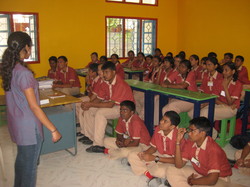Educating students in India about education in the U.S.

I talked about American education and culture to 9th and 10th standard students at the Boaz Public School in India.
“Well, I think that they are very different from schools in the U.S.,” I responded. And that was true, but there was more to it.
I stood before a class of a little more than 50 students in 9th and 10th standard (grades are called standards in India). The students were from the Boaz Public School, a school created in honor of my great-grandfather Dr. G.D. Boaz, a famous psychologist in Chennai, India. Boaz Public School stands 4 floors tall and is full of brightly colored classrooms and enthusiastic students from the ages of 3-16.
I had the opportunity to talk to these students about my life in America and about how education in America is different. They filed into the classroom and sat three to a bench, and when the benches were full they sat on the floor and looked at me with wide eyes.
I told them a little bit about myself: that I was born in America but my parents were both Indian, that I lived in Ann Arbor and would be going to the University of Michigan in the fall, and that I wanted to go into medicine and major in English.
College admissions in India are entirely different. In America, most colleges will say that they look for a balance between good grades, good test scores, involvement in extracurricular activities and volunteer work, and leadership skills. In India, it all comes down to your grades and your test scores. Many of the students were surprised to hear that many Americans practice sports for two hours after school each day.
I asked for a show of hands for how many people wanted to go into medicine. Almost half the room raised their hands. I asked people who were interested in engineering to raise their hands, and it seemed like almost the other half raised their hands. One student shyly raised his hand for law.
In India, people go straight into engineering, medicine, or law from high school. This, to me, is not the same as an undergraduate education. I talked about how in America, undergraduate education is a chance to prepare for professional studies like medicine and law, but it is also time to explore other fields of study and pursue other passions.
After I had talked briefly about everything that I had wanted to talk about, the students had a chance to ask me any questions that they had about life and education in the U.S. They asked about how classes are taught, what teachers are like, what punishments are enforced, everything.
“Would you come to India to study?”
Quite a few students were curious about what I personally thought about the Indian system of education. If I had grown up in India, or if I had wanted to go to college in India, I would be going straight into medicine in the fall. That would be exciting and I would love it.
But at the same time, undergrad is my chance to take classes in other subjects and learn things that will give me a more holistic perspective as a doctor. There are also things I can do as an undergrad before I get to med school that can help me as a doctor.
When premed students in America go through experiences like volunteering and studying abroad in other cultures and research, they take the time to realize that medicine is really what they want to do, which makes more dedicated and determined doctors. And I’m looking forward to these experiences as things that will shape me into a better person.
But for me personally, I reacted to the question with a simple answer. “No. If I did, I wouldn’t be able to study English.”
Trisha Paul will be a University of Michigan student in the fall who will write about Ann Arbor as a college town. You can reach her at tkpaul@umich.edu.

